Food pricing is one of the key factors that determine access to food. An increase in food prices reduces the purchasing power and therefore limits the quantity of food that can be purchased. The food inflation rate has more than doubled in the past year to 13.8% as of June 2022 from 6.32% in June 2021 as shown in Figure 1. Some of the items in the food basket driving food inflation include wheat, cooking oil, maize flour, milk, potatoes, onion and carrot. The highest average price change is recorded for maize flour at 67% as shown in Table 1. Kenyans through social media campaigns have been pressuring the government into taking specific actions on food prices.
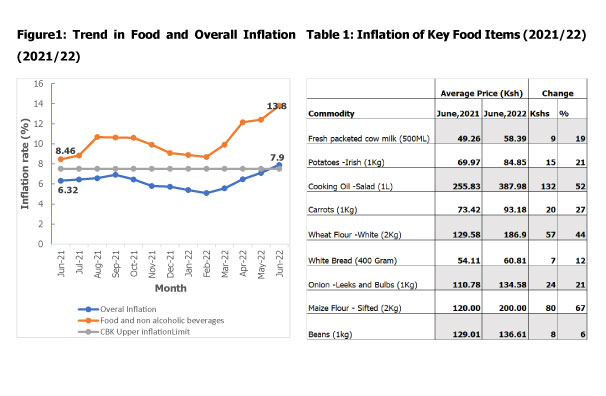
Measures taken by the Kenya Government on Food Inflation
The government has put in place policies to control food inflation in Kenya. These include fertilizer subsidies set up to help shield the farmer from the high cost and ultimately protect consumers from the high food prices. Subsidies, however, are unsustainable and have been proven to distort the market with a negative outcome. Kenya through the first schedule of the VAT Act (2013) has exempted food items such as eggs, maize, unprocessed milk, meat, and tubers from VAT. Further, the government, from 1st July 2022 waived all levies on maize imports to help curb inflation. However, food price inflation has not relented despite the above measures.
Irrigation interventions have been put in place by the government to reduce reliance on rain-fed agriculture. This has, however, not yielded the desired goals. Only 1.7% of land in Kenya is under irrigation. The existing irrigation schemes have failed to realize their potential, contributing only 3% to Kenya’s GDP. Policies targeted to reduce post-harvest losses by half in the year 2025 have been implemented but are yet to produce results. Bodies such as the National Cereals and Produce Board (NCPB) have not achieved the
goal to stabilize food prices. There is, therefore, need for more intervention to shield consumers from the rising food prices.
What are the Factors Contributing to the Rising Food Prices in Kenya?
Importation of food products
Kenya relies on imports to meet its growing food demand. The country’s import dependency ratio on food is 14.5%. Food imports put Kenya in a vulnerable position regarding economic shocks in the global market. The global supply shocks that have contributed to the current rise of food prices in Kenya are the COVID-19 pandemic, the Russia-Ukraine war, and the export restriction of palm oil by Indonesia.
The war between Russia and Ukraine that began on 24th February 2022 has affected the global wheat supply chain. Kenya sources 44% of its wheat from Russia and Ukraine. The sanctions imposed on Russia have led to an increase in wheat importation costs, with the landing cost in Kenya increasing to US$ 500 per ton from US$ 400. The Russia- Ukraine war has led to a surge in fuel prices in Kenya, leading to high production and transportation costs and thus affecting the distribution of food commodities. Export restriction of palm oil by Indonesia in the period between February 2022 and May 2022 also contributed to the rise in cooking oil prices as Indonesia is Kenya’s largest supplier of palm oil.
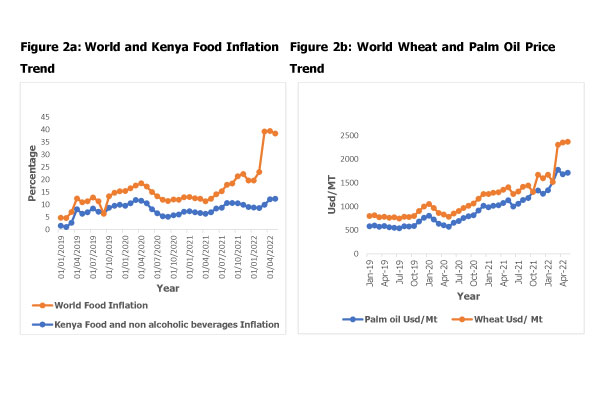
Weather conditions
Since agriculture in Kenya is largely rain-fed, farming is mainly dependent on favourable climatic conditions for a good harvest. In 2021, the short rains resulted to low harvests throughout the country. The situation is set to worsen in 2022 due to delayed long rains. Drought has historically led to increase in food prices.
Figure 3 below shows a sharp spike in food inflation during the drought period 2011 and 2017 and the trend is now being observed in 2021/22.
Figure 3: Food Inflation
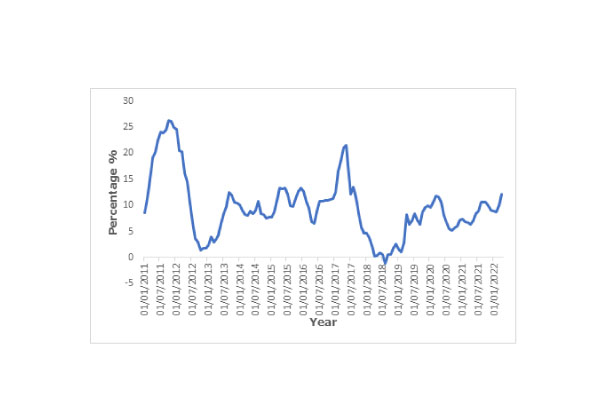
Cost of production
The rising cost of farm inputs such as fertilizers drove the cost of production high and ultimately resulted in increased food prices. Kenya imports fertilizers from the global market and is thus vulnerable to the price inflation experienced in the domestic market. The price of fertilizer in the global market has been rising as shown in Figure 4a and 4b. This ultimately increased the prices of fertilizers for farmers who depend on the import to practice agriculture.
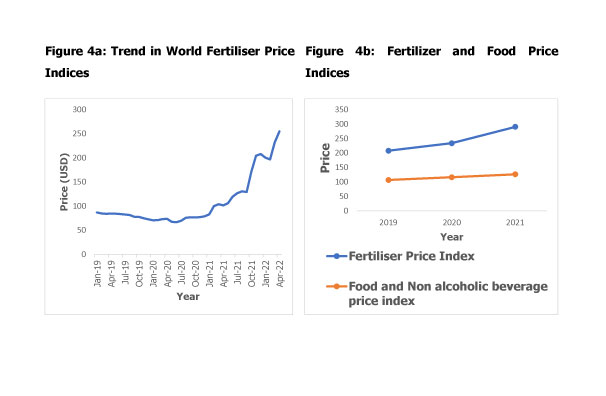
Depreciation of Kenya shillings against the dollar
The Kenya shilling has depreciated by 8.8% in the period June 2021 to June 2022. This is likely to affect imported food prices. Figure 5 shows the trend in depreciation.
Figure 5: Exchange Rate 2021/2022
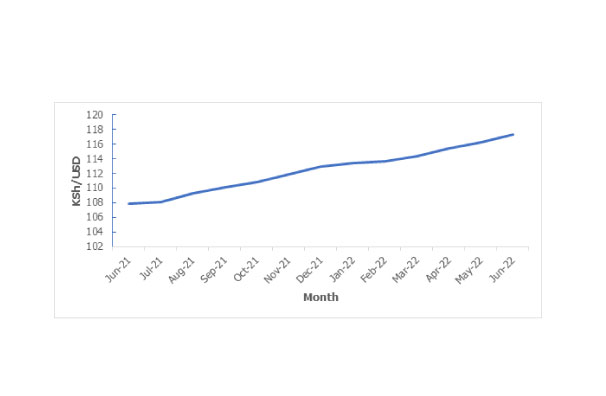
Market imperfections
Farmers tend to hoard maize in anticipation of better prices. According to the Ministry of Agriculture, Kenya maize farmers export their produce to Southern Sudan, Tanzania, and Uganda due to high prices leading to a maize deficit in the Kenya market. The maize scarcity has led to an increase in the cost of maize flour.
Way Forward
Increase budget allocation to the agriculture sector. Kenya requires heavy investment in agriculture to move from food deficiency to sufficiency. Being food sufficient will protect the public from the effects of global shocks because of importing food. The 2022/23 budget allocation for agriculture is way below the required 10% by the Comprehensive Africa Agriculture Development Programme (CAADP). The increase in allocation will enable more investment in storage facilities that can help reduce post- harvest losses. Increased allocation can also result in more investment on irrigation schemes that could raise agricultural productivity. Investments could be used in providing more extension service to farmers to improve their productivity. The ration of extension service officer to farmer in Kenya stands at 1:1800 against the recommended 1:400 by FAO.
Responding to climate change. Although Kenya has a climate smart agriculture strategy to promote high value agriculture, this has not translated to climate smart agricultural practices among farmers. There is still inadequate awareness of some of the climate smart agricultural practices by farmers to help in building resilience against climate change and reduce over-reliance on rain-fed agriculture. The Ministry of Agriculture in collaboration with counties may consider promoting climate smart agriculture solution by localizing the content to enable fast adoption by farmers. These practices include: supplying drought resistant crop varieties to farmers, training farmers
on use of more efficient production technologies, e.g. hydroponics and aquaponics, training farmers on best disease and pest management practices, providing targeted training extension services for agriculture and food-industry professionals, and promoting balcony farming in urban dwellings for a more sustainable farming and food system.
Reduce cost of production. The reliance of Kenya on fertilizer importation exposes it to the adverse effects of the inflation in the global market. The government needs to invest in fertilizer plants to promote locally made fertilizer to shield farmers from erratic price changes at the international market. The government through subsidies has tried to shield farmers from high fertilizer prices; however, the cost is still high. The Government of Kenya may consider tax exemptions on fertilizer to make it more affordable and accessible to farmers. These measures will help in reducing the high food prices Kenya has been experiencing in the recent past.
Hoarding laws. The current law against hoarding under the Competition Act 2010 that allows a 10% penalty on gross revenue has not deterred food hoarding behaviour by suppliers. The legislators could consider raising the penalty to make it more punitive for person(s) found guilty of hoarding food. High penalties could help in reducing the high food prices because of artificial shortages created through hoarding.
Authors: Dire Dika Bilala, Young Professional, Governance Department
Valerie Nyaboke Nyachieo, Young Professional, Macroeconomics Department






